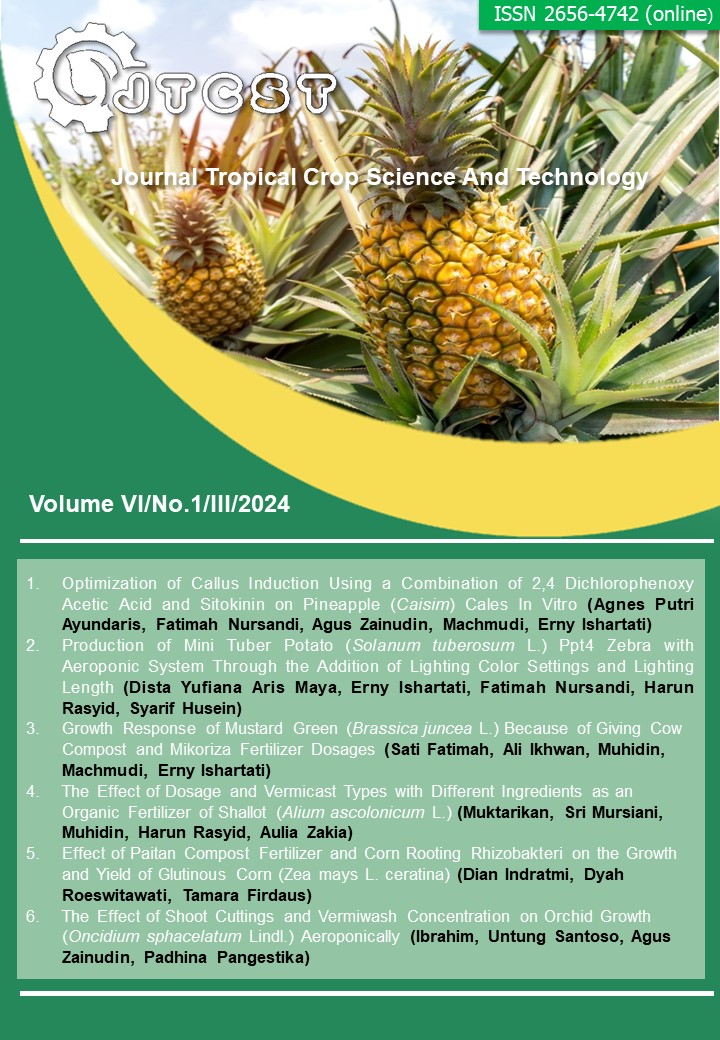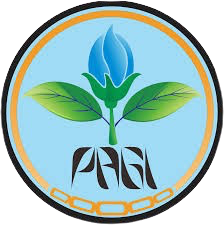Optimization of Callus Induction Using a Combination of 2,4 Dichlorophenoxy Acetic Acid and Sitokinin on Pineapple (Smooth cayenne) Cales In Vitro
DOI:
https://doi.org/10.22219/jtcst.v6i1.32887Keywords:
Ananas comosus (Smooth cayenne), 2,4-D, CytokininAbstract
In Indonesia, pineapple is one of the horticultural commodities that has the potential to be developed. It is seen that the amount of demand for fresh pineapple from abroad is quite high. Intensification of pineapple land is still lacking where the number of pineapple seedlings planted has only reached 2,500 from ideally 10,000 stems per hectare. Alternative to overcome this problem is by propagating plants in vitro through callus induction which later is thought to potentially have quality and quantity seeds as expected. This study uses a combination of ZPT 2,4-D and cytokines which are expected to grow callus with good quality and relatively faster time.This study uses Factorial Randomized Block Design (RBD). By using the first factor namely 2,4-D concentration and the second factor cytokines (BAP and TDZ). The data can be analyzed for variance and a real honest test (BNJ) level of 5%. Based on the results of the study, it was found that the combination of giving concentrations to 2,4-D and cytokines was not significant for each parameter. The interaction between 2,4-D growth regulators and cytokinins has no significant effect on the induction of pineapple varieties of Smoooth cayenne. The treatment of 2,4-D 0 mg/L - 5 mg/L growth regulators has no significant effect on callus induction in vitro on the Smoooth cayenne varieties. The treatment of cytokinin (Thidiazuron 0.001 mg/L - 0.1 mg/L and BAP 0 mg/L - 4 mg/L) had no significant effect on in vitro callus induction on the Smoooth cayenne varieties.
Downloads
References
Darwati, I. 2007. Pengaruh Jenis Eksplan Dan 2,4-D Terhadap Pertumbuhan Kalus Purwoceng (Pimpinella pruatjan Molk). Bogor: Penelitian IPB
Elfiana. Prospek Pengembangan Dan Penyediaan Bibit V.D. (2012). Prospek
George, E.F., and P.D. Sherring ton. 1984. Plant Propagation; by Tissue Culture. Exegetic Ltd. England.
Gunawan, N.A. Mattjik. E. Syamsuddin, N.M.A. Wiendi dan Ernawati. 1987. Bioteknologi Tanaman. Pusat Antar Universitas Bioteknologi. Bogor. IPB.
Lubis, RRB., Daryanto, A., Tambunan, M. dan Rachman, HPS.2014. Analisis Efisiensi Teknis Produksi Nanas: Studi Kasus di Kabupaten Subang, Jawa Barat. Jurnal Agro Ekonomi, 32 (2): 91-106.
Santoso, U. dan Nursandi, F. 2002. Kultur Jaringan Tanaman. Universitas Muhammadiyah Malang Press: Malang.
Septia, E. D., Nursandi, F., Santoso, U., Fauziyah, F., Zulfahmi, I., Zulfan, I. M., ... & Saputra, P. H. (2023). Pendampingan Inovasi Produksi Pupuk Organik Cair Berbasis Urine Sapi pada Petani Nanas Kecamatan Ngancar, Kabupaten Kediri, Jawa Timur. Martabe: Jurnal Pengabdian Kepada Masyarakat, 6(11), 3893-3900.
Statistik Pertanian Hortikultura (SPH) yang diterbitkan oleh BPS. Buku “Angka Tetap Hortikultura Tahun 2014”. (Diunggah: 15 September Pengembangan Dan Penyediaan Bibit.
Downloads
Published
How to Cite
Issue
Section
License
Copyright (c) 2024 Agnes Putri Ayundaris, Fatimah Nursandi , Agus Zainudin , machmudi, Erny Ishartati

This work is licensed under a Creative Commons Attribution-ShareAlike 4.0 International License.
Authors who publish with this journal agree to the following terms:
- Authors retain copyright and grant the journal right of first publication with the work simultaneously licensed under a Creative Commons Attribution License that allows others to share the work with an acknowledgement of the work's authorship and initial publication in this journal.
- Authors are able to enter into separate, additional contractual arrangements for the non-exclusive distribution of the journal's published version of the work (e.g., post it to an institutional repository or publish it in a book), with an acknowledgement of its initial publication in this journal.
- Authors are permitted and encouraged to post their work online (e.g., in institutional repositories or on their website) prior to and during the submission process, as it can lead to productive exchanges, as well as earlier and greater citation of published work (See The Effect of Open Access).











